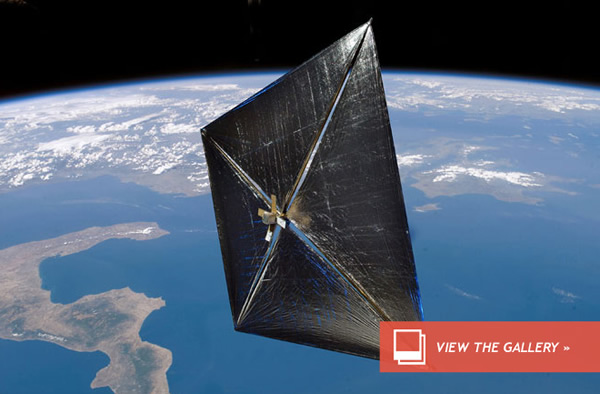Voyage of the Sunjammer: Sailing on Solar Winds
Voyage of the Sunjammer: Sailing on Solar Winds
Solar sails are a beautiful and entirely intuitive concept.
The sun, like all other stars, emits an immense amount of photons, as well as a steady stream of charged particles. This “solar wind” actually exerts a not insignificant amount of pressure on everything which orbits the sun. It’s enough to blow out the glorious tails of comets, like the ones that should be visible in the skies later this year, and to be gradually eroding Venus’ atmosphere. Also, just like the wind here on Earth, space weather can be used to power sails.
Despite being a mainstay in some science fiction works, solar sails are a very real and attainable technology. The latest development being the Sunjammer, a joint project between NASA and California-based aerospace company L’Garde.
At over 1,200 square meters (13,000 sq. ft.) in area, Sunjammer will be the largest solar sail ever constructed. It’s currently scheduled for launch in 2014, and will travel approximately 3 million kilometers (1.9 million miles).
The best thing about solar sails is that they’re effectively free spaceflight. Most spacecraft need a significant amount of space to be set aside for fuel. This means that solar sails may well be the most economical way to travel. After all, the sun already provides a huge amount of energy to everything within an 18 billion kilometer (11 billion mile) radius. Why not spacecraft too?
Solar sails aren’t a new concept. In fact, the idea is surprisingly old. The first to notice that comet tails always point away from the sun was Johannes Kepler. In a letter to Galileo in 1610, he noted: ”Provide ships or sails adapted to the heavenly breezes, and there will be some who will brave even that void.” In the 17th century, of course, powering a ship with anything other than sails would likely have seemed ludicrous.
400 years after Kepler’s original inspiration, JAXA launched IKAROS, the first true solar sail ever built; a few sails had been created previously, but none had successfully demonstrated propulsion. Deployed in June 2010, IKAROS had a sail 200 square meters in size, constructed from polyimide with LCD Panels built in to allow attitude control by adjusting the sail’s reflectance. Reaching a velocity of around 100 meters per second (224 miles per hour), IKAROS reached its destination at Venus roughly 6 months after its sail deployed.
NASA too had a solar sail craft, known as Nanosail-D. Sunjammer, however, will be a dramatic improvement over these previous endeavors. The sail, with an area just under a third of an acre, will be deployed after the craft is launched into space — unfurling from a vehicle the size of a dishwasher, weighing just over 30 kilograms in total. This is probably one of the most ambitious spacecraft propulsion concepts ever tested. However, at the same time, the deployment mechanisms for solar sails have been well tested previously.
The sail itself will be made from a high tech material called Kapton — also used in space suits, where it serves the threefold purpose of thermal insulation, shielding from solar radiation, and protection from micrometeoroids. Made from this surprisingly tough material, the sail will be buffeted by photons from the sun, together with the charged particles which make up the solar wind; solar charged particles, mostly protons and electrons, also get caught up in the Earth’s magnetic field and cause the stunning displays of aurorae in polar regions.
The effective thrust which a solar sail can achieve is roughly 0.1 Newton — around the same force exerted by Earth’s gravity on a packet of sugar which you might stir into your morning coffee. This may seem tiny to us here on the surface of our planet, but it’s comparable with certain existing space propulsion technologies. For example, that’s actually more power than the ion thrusters that are currently propelling NASA’s Dawn spacecraft from Vesta to Ceres in the asteroid belt.
If the name “Sunjammer” sounds familiar to any science fiction aficionados, it probably should. It’s the name of a short story by Arthur C. Clarke about an interplanetary yacht race. Mind you, it may be a few more years before we can properly use solar sails as propulsion.
All the same, it has to be said that the prospect of both economical interplanetary travel and yacht races in deep space is certainly enticing!
Mar 5, 2013 02:09 PM ET by Markus Hammonds












